
In the scheme of pushing forward the electrification of automobiles, General Motors took somewhat of a methodical approach to things and a justified stab at bringing us affordable EV (electric vehicle) options. First, it was the Chevrolet Bolt in its two variations, and now we have the attractive offering of the new Chevy Equinox EV.
With me being brutally honest, the Chevrolet Equinox, in its gas-burning form, never really impressed me much as it was a background-blending, well-to-do form of a mainstream compact crossover. Now, having an electrified Equinox, which is fundamentally a different vehicle from the gas Equinox, there’s a little added excitement when zooming out to consider the collective of its somewhat ‘affordable’ parts. Those highlighted parts include advanced tech, efficiency, and a good driving character, all bundled up in a good-looking and decently sized package.
Also, don’t forget that you can get discounted new car pricing with a free quote through qualified local dealer partners.

As an EV that will eventually start around $34K before any government incentives for a forthcoming 1LT base trim later this year, the new Chevy Equinox EV becomes quite the attractive buy with an electric range of up to 319 miles. GM’s Ultium battery propulsion platform appears to go the distance to fit the American lifestyle. My Equinox EV 2LT eAWD test vehicle proves such, and even with a range figure that’s slightly down from the standard FWD setup, there’s a lot to appreciate in the added power from the dual motors touting a total of 288 horsepower and 333 lb-ft of torque. Such power is a result of having two motors in the eAWD optioned vehicle where you have a rear 241 horsepower/225 lb-ft motor and a 90 horsepower/121 lb-ft front motor. Otherwise, with a standard front-wheel-drive setup, you’re left with just one motor producing 213 horsepower and 236 lb-ft of torque, which I imagine is somewhat lackluster in its acceleration performance, but you do benefit from a longer range of 319 miles versus my 2LT eAWD test vehicle’s 285-mile range. You can get the eAWD option on any trim level, which will soon be listed on Chevrolet’s website for availability at an additional cost of $3,300.
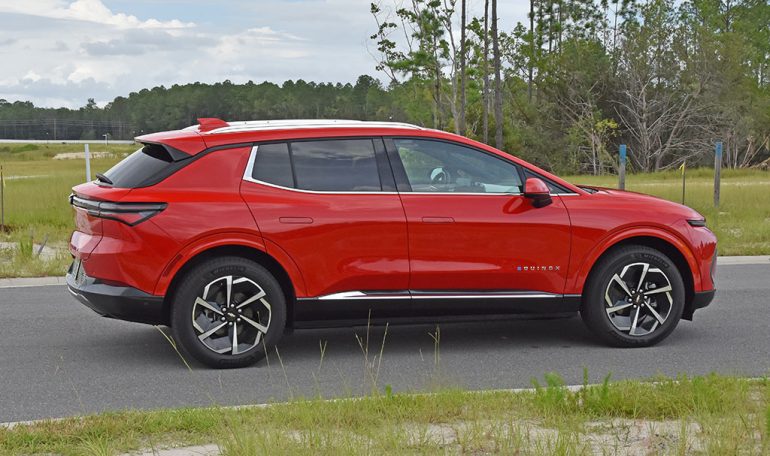
Overall, the driving character is excellent, and the quality is just as good, where things feel far better than something like the Ford Mustang Mach-E. There’s more compliance in the ride quality, though it doesn’t necessarily feel as planted as the Mustang Mach-E, as the Mach-E is more of the performance leader, even if some do not technically classify these vehicles as direct competitors. Fundamentally, consumers will cross-shop the two, especially when you consider the pricing scale for matching feature content.
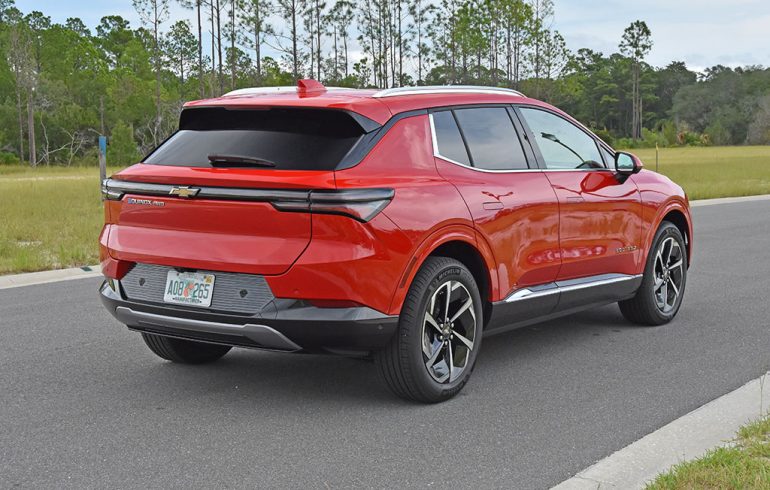
There’s something special about how the Equinox EV eAWD drives and the fundamentals of the electric drivetrain. For one, the default deceleration is spot on for mimicking a gas-burning vehicle’s behavior. There’s also the option of enabling one-pedal driving, which has two modes for a medium level of regen or heavy level upon releasing the gas pedal. The one-pedal drive mode is proper for it to come to a complete stop and automatically enable auto-hold. Moreover, there’s a braking regen on-demand function through a left-side steering wheel paddle, which is convenient for getting the maximum recovery of energy upon aggressively slowing along with the expectation of the braking light, which stays on until you press the gas pedal.
There are four drive modes: Normal, Sport, Snow/Ice, and a configurable My Mode, which are accessed only in the infotainment system. In Normal or Sport mode, full throttle feels the same, and you should hit 60 mph from a stop in about 5.8 seconds, which is decent for such a vehicle class. According to reviews of the front-wheel-drive Equinox EV, it looks to take 7.7 seconds to hit 60 mph.
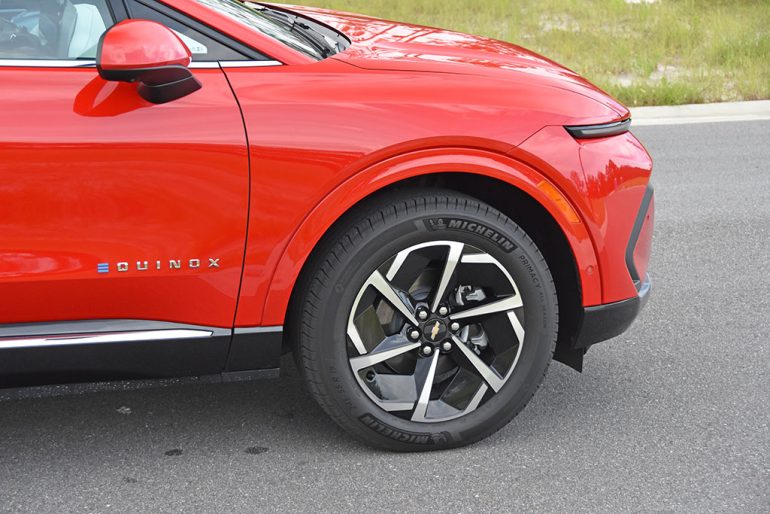
The new Chevy Equinox EV, in its front-wheel-drive setup, has a respectable range of 319 miles. However, adding on the eAWD option, which gives you the desirable extra power, brings the range down to 285 miles. That figure appears to fit in for the real world but rising above 75 mph or so seems to shorten the range below 285 miles from my estimates. Around town, I saw an end-point of besting the range estimate, which I could have ended with just over 290 miles in a full charge, but I just didn’t have the time or city roads to travel for that distance. Overall, the combined EPA figures for 101 MPGe city, 90 MPGe highway, and 96 MPGe are close to real-world estimates.
When it comes to charging, using my home Level 2 240-volt charger, the Equinox EV AWD with its 85-kWh battery pack charged up at a rate of around 9.5 kW, which could charge up a depleted battery in just under 9 hours. However, the onboard 11.5 kW charger permits slightly faster Level 2 charging with the proper equipment. My setup at home is a 50amp connection to my power, potentially limiting that output. Taking advantage of the onboard charger’s capability you can charge up the vehicle in just over 5 hours.
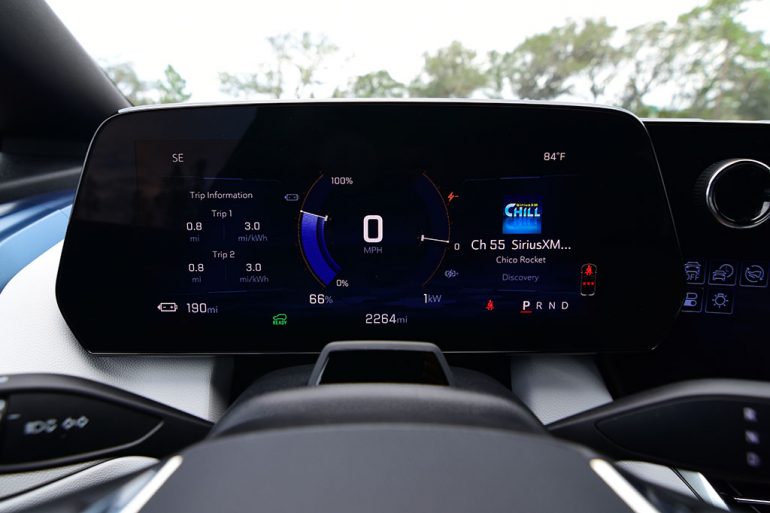
Use of a DC fast charger and a 150-kW connection, you will be able to charge from 10% to 80% in about 50 minutes, while Chevrolet sticks by its claim of adding 70 miles of range in just 10 minutes. The interesting thing when testing the Equinox EV is that you can get a slightly higher charge speed using a 350-kW charging stall, while at a 150 kW stall, the rate of charge is far below 150 kW, never reaching the vehicle’s capability of hitting 150 kW. So, the Chevrolet claim of 70 miles of range added in 10 minutes seems to be more reliable when using a 350-kW charger, even though there’s just a 150-kW capability. Here, you have the technicality of supplying much more than you need, as many charging stations don’t necessarily max out their stated capacity.
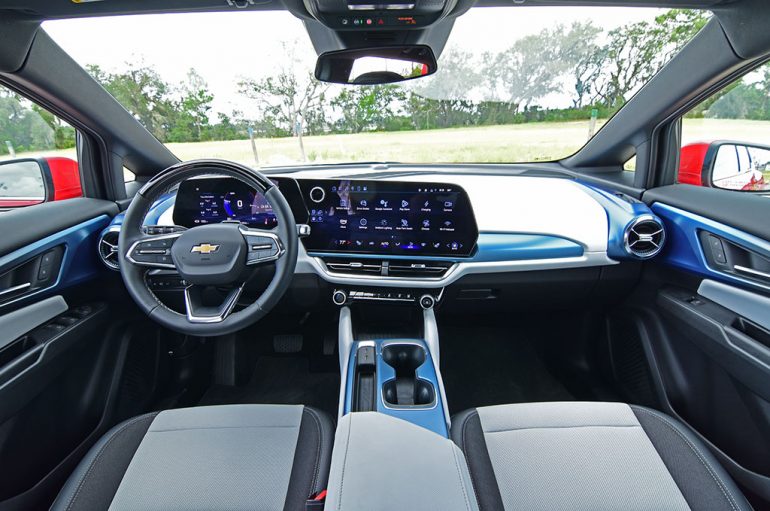
Inside the new Equinox EV 2LT eAWD there’s a very inviting cabin, one that’s levels above the outgoing gas-burning Equinox. In fact, there’s nothing that’s shared with the two other than the name unless you consider the redesigned 2025 Equinox, which brings some familare dashboard content. The Equinox EV is more premium and fits its positioning for its higher pricing, even with it being an EV. The cabin even feels bigger and is just miles above the gas sibling for being more premium in just about every area.

The seating positions have plentiful space up front with a lot of adjustment. Being a bigger guy at just over 6 feet tall, I fit perfectly fine and could easily find a good driving position. The front heated seats are mostly comfy, and the rear is set up in a 60/40-split seatback configuration. The cargo room behind the back seats is good as well, with just over 26 cubic feet of space. Fold the seatbacks down, and you have 57.2 cubic feet of storage, all accessed by an Autosense power liftgate. Unfortunately, there is no front trunk (frunk) as opening the hood reveals the front motor and components only.
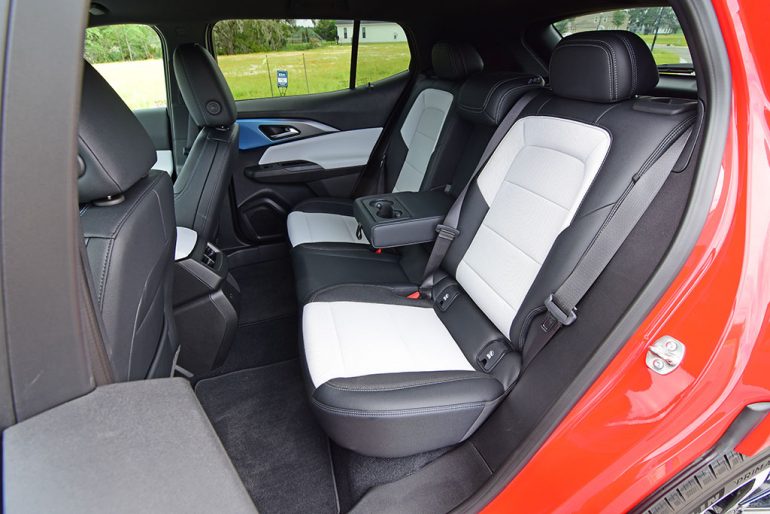
Chevrolet does well with the Equinox EV to serve up plenty of content, including a new Google-based touchscreen infotainment system fed through a large 17.7-inch screen. Here, the setup is wonderful, and after a short learning curve, the use of the system becomes an easy task. However, and it’s a big however, there are many things about the new setup that just didn’t have to be and where I believe no one really asked for features such as the vehicle starting up automatically by pressing the brake pedal, and shutting off automatically upon parking the vehicle, quickly unbuckling, and exiting the vehicle. Otherwise, there’s an onscreen shutoff button sequence to manually turn off the vehicle. Such a feature, along with having so many common controls embedded into onscreen functions like the dome light, headlights, and even the window lockout, is just not necessary in my opinion. It’s almost like the engineer for such spent a little too much time in Tesla vehicles. Maybe some will like the ‘hidden’ features. On the other hand, I just think adding a start/stop button along with some buttons for those simple controls is something no one will ever complain about.
Then, there is the other unfortunate situation where there is no Apple CarPlay or Android Auto integration, which has been a big topic among consumers ever since the announcement was made to not integrate such a feature in new GM EVs. With the Chevrolet Equinox EV being my first run-in with a vehicle without Apple CarPlay in about ten years, there’s a bit of natural disappointment here. I feel as if I’ve been teleported back about ten years when attempting to make easy and non-distracting use of my “connected” iPhone in a vehicle. Essentially, the Google/Android-based infotainment system is good. But connecting your iPhone via Bluetooth and utilizing generic folders to sift through your music playlists is just not going to cut it for me in the year 2024. I feel as if I’ve been robbed of an essential feature where over 95% of modern-day vehicles have Apple CarPlay as an expected staple feature. I gave it a chance; I used the infotainment unit connected to my iPhone for a full week, and I just couldn’t come to any agreeable compromise to be happy with the limited connectivity integration. Even though you could still have Google read your texts or make calls via voice, there’s a lot missing. I even allowed the installed Waze app to be a soothing transitional piece, but at the end of the day, GM made a mistake, and they could very well pay for it considering how much the end result of getting into a vehicle like the Equinox EV 2LT eAWD will set you back – more on that later.

The new Chevrolet Equinox EV bundles up all of the expected active safety features to be standard across all trim levels. You have your typical forward collision alert with emergency braking, blind-spot monitor, rear cross traffic alert and braking, reverse automatic braking, traffic sign recognition, and even a 360-degree HD vision camera system. My vehicle was equipped with the optional Super Cruise package, which brings the latest version of GM’s highly praised Super Cruise system, which again proved to be one of the best hands-free driving systems on pre-mapped highways and interstate roads. This time around, I did notice that the automatic lane change feature was somewhat aggressive but worked nearly seamlessly every time the computer decided to move over to the right lane to cruise while allowing fast-lane traffic to pass by.

EVs are traditionally a controversial topic that is often opinion-forming based on pricing, and rightfully so in many cases. Chevrolet has managed to do a slight undercut for the soon-to-be-released Equinox EV 1LT base trim that will start at around $34,000 making it one of the least expensive new EVs in America. But until such a trim arrives, the Equinox EV starts at $41,900 before any fees or options, which, after bundling up a few options packages in my 2LT eAWD test vehicle, the pricing comes to $49,295 after a $1,395 destination charge. Such a price will have many talking, some good and some going against the accepting grain of EVs. While $49K is the average price for a new car nowadays, many consumers are still optimistically cautious about the pricing of EVs and the general scope of new vehicles with today’s inflation. The question they’ll ask me is if the new Equinox EV 2LT eAWD is worth its price. Sure, I will say, but only if you consider the totality of what it offers and factor in the cheat code of having a federal tax credit of up to $7,500 – Then it’s worth its price of admission all day long – if you won’t miss Apple CarPlay.
Be sure to get the best pricing on a Chevrolet Equinox EV from our network of local dealerships.